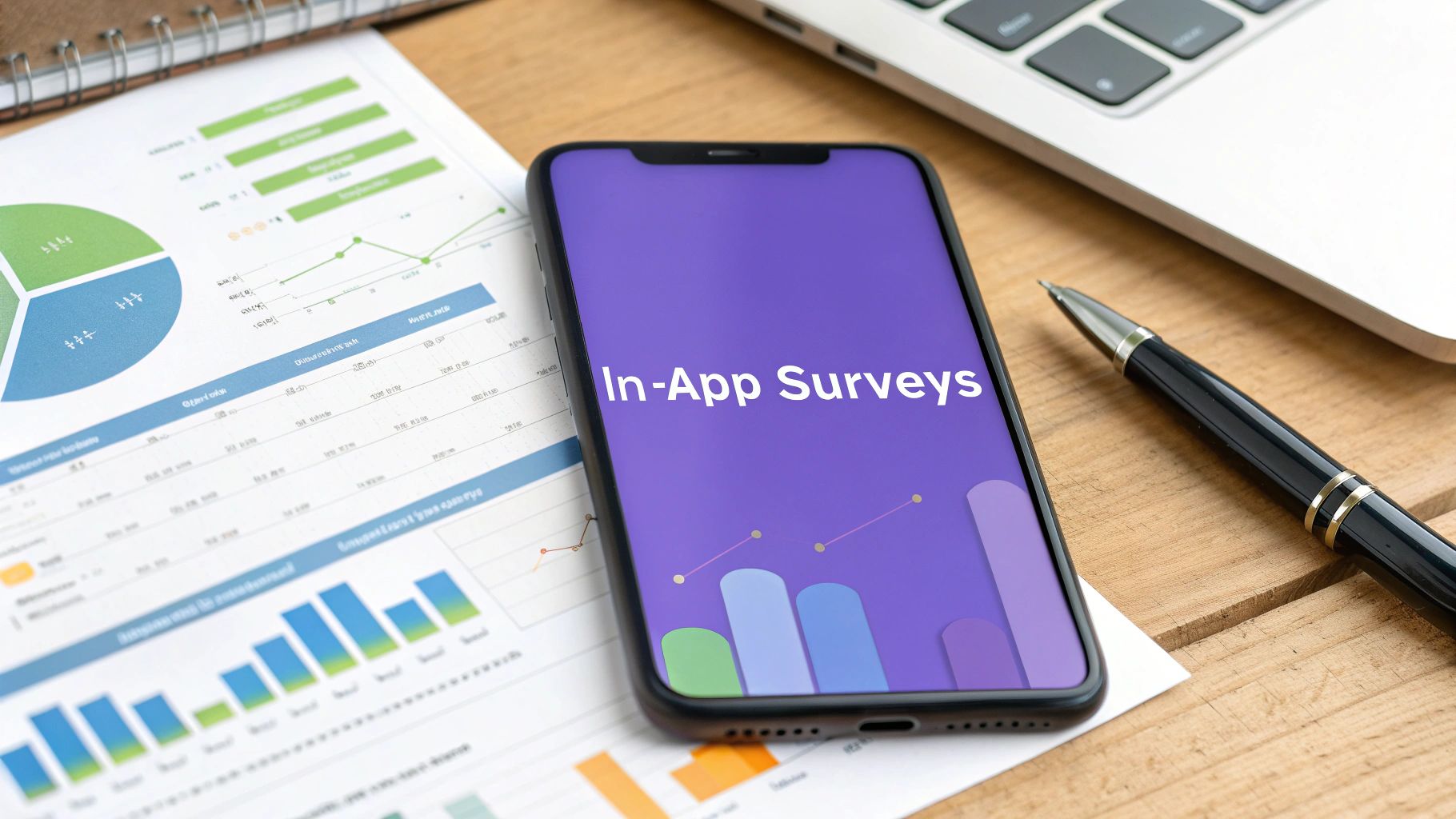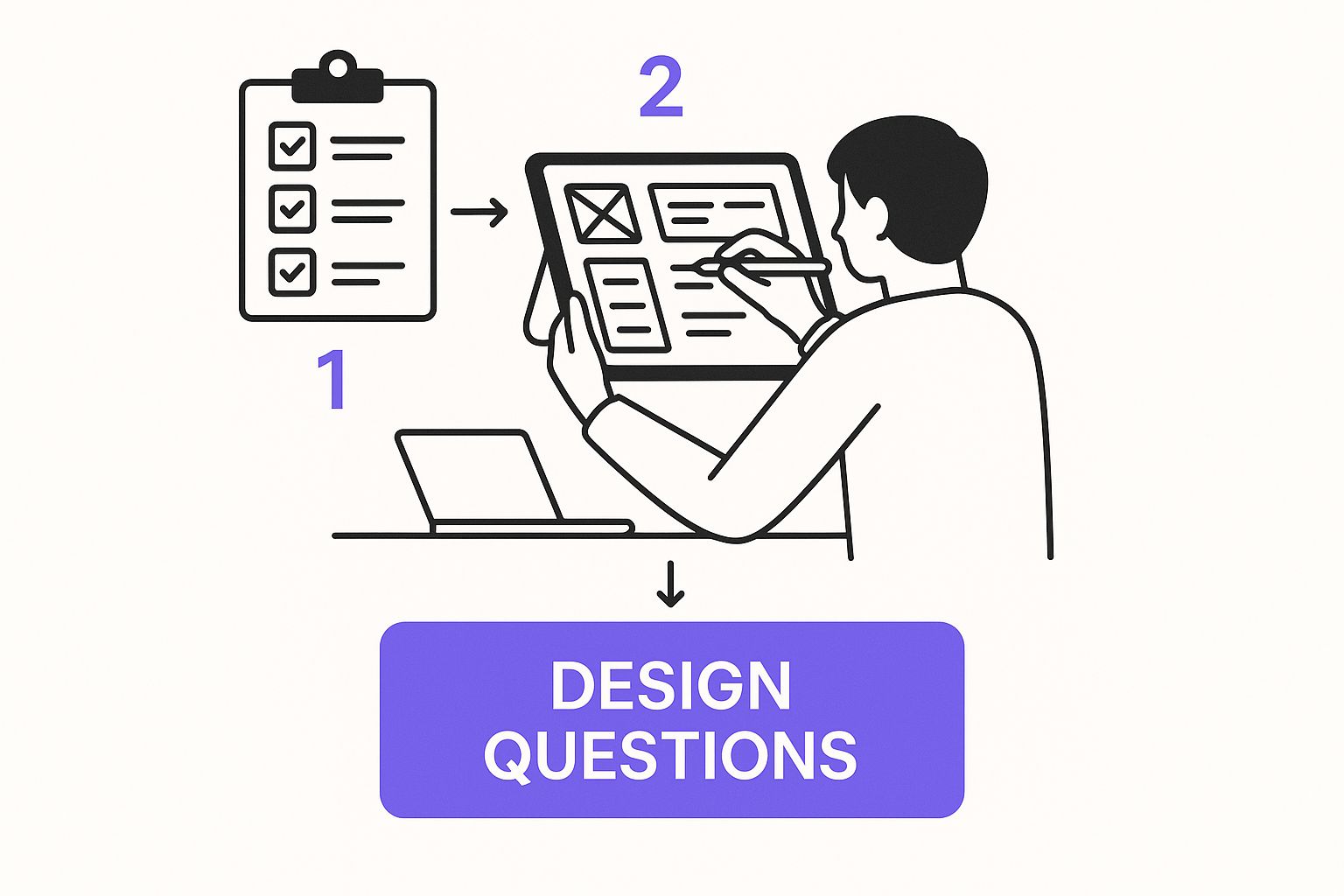
Imagine you could have a quick, quiet chat with a customer right at the moment they’re using your product. That’s the real magic of in-app surveys. They aren't just another feature; they're a direct line of communication built right into your mobile app, letting you gather insights with an immediacy that old-school methods like email can't touch.
Think of an in-app survey as a perfectly timed tap on the shoulder. Instead of emailing someone days after they used your app—when the details are fuzzy—you can pop the question at the most relevant moment. Maybe it's right after they've made a purchase, tried a new feature, or even bailed on a task midway through.
This immediacy is what makes them so effective. The feedback you get is contextual, fresh, and way more accurate than anything you’d get from a follow-up email. It’s the difference between a chef asking "How's the steak?" while you're eating it, versus calling you next Tuesday to see if you enjoyed your dinner.
In a market flooded with options, understanding what your users are thinking isn't a "nice-to-have"—it's a survival skill. In-app surveys let you stop guessing what people want and start making decisions backed by real data, which is exactly what fuels growth. The money flowing into this space tells the same story.
The global app analytics market, which includes tools for in-app surveys, hit a value of US$8.52 billion in 2024. It’s expected to explode to US$48.06 billion by 2033, a surge driven by the demand for deeper user analytics. You can learn more about the app analytics market forecast.
This trend points to a major shift in thinking. Companies are no longer on the fence; they're investing serious money into tools that give them a direct pipeline to the user's voice. This feedback isn't just for product managers anymore—it's gold for marketing, customer success, and the entire business strategy.
When you capture this kind of feedback, you can build a stronger, more user-focused product. Here’s what that looks like in practice:
At the end of the day, in-app surveys create a continuous feedback loop. Your users feel heard, and their insights become your most powerful tool for building a product that lasts.

It’s easy to think of in-app surveys as just a way to collect opinions, but they're so much more than that. When used correctly, they become a powerful business tool that turns raw feedback into real, measurable results. They help you shift from putting out fires to proactively building a better product, using direct customer insights to guide your decisions.
Think of your app as a living, breathing thing. In-app surveys act like its nervous system, giving you instant signals about user satisfaction and behavior. This direct feedback loop is your secret weapon in a crowded market.
Let’s get straight to the point: the biggest win here is stopping churn in its tracks. Imagine a user hits a snag—a confusing button, a glitchy feature, or a workflow that just doesn’t make sense. A well-timed in-app survey can catch that frustration the moment it happens.
This gives you a chance to pinpoint and fix the exact problems that make people leave. When you solve these issues quickly, you're not just fixing the app; you're showing users you listen. That builds incredible loyalty. A deep understanding of what your users are telling you is essential for mastering app engagement metrics and keeping them around for the long haul.
Your internal team is smart, but they aren't your customers. In-app surveys bridge that gap, giving you a direct line to the people who use your product day in and day out. This provides priceless validation for your product roadmap.
By turning feedback into a strategic asset, you can prioritize development with confidence, ensuring you build features that customers will actually use and love.
Instead of sinking months into building a feature based on a hunch, you can test the waters first. Send a quick survey to a segment of your most active users and ask them flat-out if a new idea is useful. This data-first approach saves a ton of development time and makes sure your team is working on things that actually matter.
Believe it or not, your happiest customers are often your most silent ones. They love your app and use it all the time but never think to leave a review. In-app surveys can gently nudge them in the right direction.
For instance, you can set up a survey to pop up right after a user does something positive, like completing a task or making a purchase. A simple, "Are you enjoying the app?" can quickly identify your fans. If they say yes, you can then follow up with a prompt asking them to share their thoughts on the app store. It's a simple and highly effective way to improve your ratings and get more eyes on your app.
This approach is becoming more common as businesses see the results. In fact, 80% of app marketers feel that 2025 will be as good or even better than the previous year for the industry. Almost half of them are increasing their budgets specifically for tools that help them connect with users more effectively.
Crafting an in-app survey that people actually want to answer is a bit of an art form. Get it wrong, and you do more harm than good—interrupting workflows, frustrating users, and souring their whole perception of your app. The real goal is to make the experience feel less like a pop quiz and more like a quick, helpful chat.
The most important thing to remember? Respect the user's time. Their attention is a finite resource. A good rule of thumb for in-app surveys is to keep them incredibly short, think one to three questions max. Any longer and you'll see a massive drop-off, leaving you with skewed data from only your most patient (or most annoyed) users.
This isn't just about throwing a question out there; it's a thoughtful design process.

As the image suggests, creating a survey is a deliberate design activity, not some last-minute task. Every question should be crystal clear, concise, and tied directly to a specific goal. This ensures every second a user gives you is put to good use.
The type of question you ask has a huge impact on the quality of feedback you get. Different formats are built for different jobs, so it's critical to match the question to your objective. A multiple-choice question is fantastic for quick categorization, but an open-ended one is what you need to uncover the "why" behind someone's actions.
A well-designed survey is a conversation starter, not an interrogation. It’s meant to gather a specific insight with as little friction as possible, making the user feel heard without interrupting their experience.
The type of question you ask completely changes the feedback you receive. To get truly actionable data, you need to match the format to your learning objective.
Ultimately, picking the right question format isn't just a technical choice; it's about signaling to the user what kind of feedback you're looking for and making it as easy as possible for them to provide it.
Even the most beautifully crafted survey will fall flat if it shows up at the wrong moment. Interrupting someone mid-task is the quickest way to get your survey dismissed and leave a bad taste in their mouth. The trick is to trigger surveys based on user behavior, catching people at a natural pause in their journey.
Think about "moments of accomplishment" or resolution. Great times to ask for feedback include:
By aligning your survey with the user's journey, the request feels relevant and contextual. This not only boosts response rates but also ensures the feedback you get is tied to a specific experience, making it far more valuable for your team to act on.

Okay, now that we’ve covered the basics, let's get to the good stuff. This is where you truly tap into the potential of in-app surveys. If you're just blasting the same questions to every single user, you're missing the point. It's like a tailor trying to sell one-size-fits-all suits—sure, it might work for a few people, but for most, it’s just going to feel off.
The real magic happens when you ask the right person the right question at the perfect moment. You do this with advanced targeting, which lets you zero in on specific user groups based on what they've actually been doing in your app. Instead of shouting into the void, you're starting a relevant conversation.
This is what turns a generic questionnaire into a source of game-changing insights. For a deeper dive into making this happen, you can learn more about granular targeting in in-app surveys.
Smart segmentation is what elevates your survey from an annoying interruption to a genuinely helpful conversation. When you group users based on their behavior, you create feedback loops that give you much richer, more specific information. It shows you respect their time and understand their unique journey with your product.
Here are a few practical ways you can start segmenting users:
When you target based on behavior, your questions instantly become more powerful. A brand-new user isn't thinking about advanced features, and a loyal power user has nothing to say about the sign-up flow they saw a year ago.
The goal is to make your question feel like a natural part of what the user is already doing. This kind of personalization doesn't just boost your response rates; it ensures the feedback you get is directly tied to a specific experience and is something you can actually act on.
This approach is more critical than ever. With projections showing a staggering 299 billion mobile app downloads worldwide in 2025, the opportunity here is massive. Every single download is a chance to connect with a user through a timely, relevant survey that makes their experience better.
By tailoring your in-app surveys to specific actions and user groups, you can finally stop guessing what people want. You start getting clear, contextual answers that pave the way for real product improvements.
Alright, let's get into the nitty-gritty of making this whole process work without it becoming a massive headache.
Moving from the idea of in-app surveys to actually doing them can feel like a huge leap. The thought of manually building, sending, and sorting through feedback for every type of user sounds like a job in itself. And honestly, it used to be.
Thankfully, we've moved past that. Modern platforms like Statisfy are built to handle the entire workflow, turning a clunky, time-consuming process into a smooth, "set it and forget it" system. The goal here is to get rid of the operational drag that holds you back. Instead of bugging developers to code and launch every single survey, you get a simple interface where you can build exactly what you need. This puts the power right where it belongs: with the customer success and product teams who can spin up a feedback campaign in minutes, not weeks.
Automation really starts to click when your survey tool isn't just sitting off on its own. The magic happens when it talks to the other systems you're already using every day. Just imagine a user drops a low CSAT score, and poof—a support ticket instantly appears in your helpdesk, complete with their verbatim feedback.
That's what platforms like Statisfy do by connecting directly to your key tools:
With an automated workflow in place, you’re basically building a smart feedback engine that runs around the clock. You set up triggers that send the right survey at the perfect moment, creating a system that learns and acts without you having to constantly push buttons. It's like teaching your app to ask for feedback on its own.
For instance, think about a user who just successfully used a premium feature for the first time. An automated trigger could send them a quick survey asking about it. If they give it glowing marks, another trigger could follow up a day later and ask for an app store review. This kind of setup ensures you never miss a chance to capture key insights or rally your biggest fans.
Here’s a look at what a modern dashboard that pulls all this together looks like.
This isn't just a bunch of charts. A central hub like this brings everything—survey insights, customer health scores, and other data points—into one clear picture. It helps your teams stop just collecting data and start making quick, smart decisions that actually improve the customer experience.
At the end of the day, automation isn't just about being efficient. It's about making your users feel like you're actually listening. When you can respond to feedback almost instantly—whether that means fixing a bug or just acknowledging a feature idea—you close the loop and build incredible loyalty.
An automated in-app survey workflow transforms feedback from a backward-looking report into a forward-looking driver of customer success. It ensures insights lead directly to action, which is what being a truly customer-centric business is all about.
By automating the mechanics of your in-app surveys, you give your team the freedom to focus on what humans do best: understanding the feedback, connecting with users, and building a product they can't live without.
As you get ready to roll out in-app surveys, a few practical questions are bound to come up. I’ve put together answers to the most common ones I hear, aiming to clear up any confusion so you can move forward with confidence.
Keep it short. Really short. The sweet spot is 1-3 questions, maximum. Your goal is to grab a very specific piece of feedback without getting in the user's way.
Think about it from their perspective: every single extra question you add is another reason for them to just close the pop-up. Longer surveys almost always lead to higher drop-off rates and messy, incomplete data. If you absolutely need more detail, you can always include a link to a longer, optional web survey. But the initial ask inside the app? It has to be quick and painless.
This is a great question and a totally valid concern. The honest answer is: yes, they absolutely can be annoying—if they’re done poorly. But when you get them right, in-app surveys can actually make users feel more connected to your product and improve retention.
The trick is all about respecting the user's time and context. Here’s how to do it right:
These are the big three metrics for measuring how users feel, but they each tell you something very different. It helps to think of them as specialized tools for different jobs.
Choosing the right metric is everything. You need to pick the one that directly maps to the specific insight you’re trying to uncover at that exact point in the user journey.
Written feedback is where you'll find the gold—the "why" behind all your scores. Sifting through it all can feel daunting, but a simple system makes it manageable. Start by tagging responses with recurring themes or keywords.
For example, you might create tags like 'bug report,' 'UI confusion,' or 'feature request.' This simple act of categorizing allows you to turn qualitative comments into quantitative data, making it easy to spot which issues are most urgent or which ideas are most popular. Many modern survey platforms, including Statisfy, have built-in tagging and sentiment analysis to help automate this, letting you find key trends without having to read thousands of entries by hand.
Ready to turn customer feedback into your biggest growth driver? With Statisfy, you can automate your entire in-app survey workflow, from targeted deployment to actionable insights. Stop guessing what your users want and start building a product they love. Learn more about Statisfy and get started today.